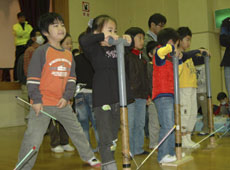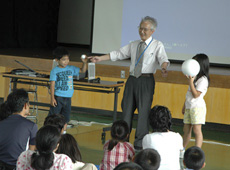Q. What are your expectations for the JAXA Space Education Center?

Children launching straw rockets

Director Sumio Endo talking about the Earth and the Moon
As far as the principle of space education goes, the Space Education Center is already on board. It has been making great efforts to make space attractive to schools and children nationwide. To further promote this principle, I would like the center to host a conference on space education. There are many space-education projects already taking place today, but most of them are operating in isolation. We need to give everyone a chance to get together and talk about their own activities and compare notes.
By doing so, the Space Education Center would make itself better known in the education community. Since the center's opening five years ago, its visibility has surely grown, and the number of schools that introduce space education is growing. In reality, though, many people still do not know about its benefits, and its visibility at a national scale is questionable. I hope that the Space Education Center will play a key role in making these benefits known , even by word of mouth, but more importantly by providing training in space education to schoolteachers.
Q. What is your vision for KU-MA?
I'm always keen to encourage children to have dreams, to brighten their lives, and to have a bright outlook for the future. I would like to continue to play a role in helping make a world where children can have dreams. In that sense, I am very happy that I can communicate with children through space education. The mission of KU-MA is to encourage children to get a well-rounded education and have a broad outlook on the world. I would like to continue the operation of Space School, hoping that the activities of KU-MA will make great contributions towards a prosperous future.
Director, KU-MA (Kodomo Uchu Mirai Association)
Mr. Endo graduated from Tokyo Gakugei University in 1962, and became a science teacher at a public middle school in Tokyo. He was appointed principal of Dai-go Middle School in Tachikawa city, Tokyo in 1991, and Dai-ichi Middle School in the same city in 1996. After serving as director of the Tokyo Association for Science Education for Middle Schools, he became director of the Japan Association for Science Education for Middle Schools in 1998 (where he is still an advisor today). From 2003 to 2007, he worked as a part-time lecturer at Tokyo Gakugei University and Aoyama Gakuin University. In the area of space education, he was counselor at the JAXA Space Education Center in 2004. He has been in his current position since 2008.
Space School for a Bright Future for Children
Developing Children's Interest in Science
Helping create dreams of space

